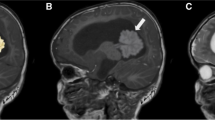Summary
A young man presented with visual loss and field changes suggesting direct chiasmal compression by a neighboring neoplasm. Contrast radiography demonstrated obstructive hydrocephalus secondary to a pineal tumor. The markedly dilated third ventricle was intrasellar in location and was causing chiasmal compression. The radiological and ophthalmological findings are discussed and correlated with of the operative findings with a review of the pertinent literature.
Résumé
Les auteurs rapportent le cas d'un homme jeune dont le déficit visuel et campimétrique suggère une compression chiasmatique tumorale. Les examens contrastés rélèvent une hydrocéphalic par pinéalome comprenant un troisième ventricule dilaté en situation intrasellaire.
Zusammenfassung
Fallbeschreibung eines Patienten mit Gesichtsfeld- und Visus-Verlust, bei dem die Verdachtsdiagnose durch einen Tumor, der das Chiasma komprimierte, bestand. Die Kontrastmitteluntersuchungen zeigten einen Verschluß-Hydrocephalus durch einen Pinealis-Tumor. Der erheblich erweiterte 3. Ventrikel rief die Chiasma-Kompression hervor. Die röntgenologischen und ophthalmologischen Befunde werden diskutiert und mit den Operationsbefunden verglichen.
Similar content being viewed by others
References
Bergland, R.M., Ray, B.S., Torack, R.M.: Anatomical variations in the pituitary gland and adjacent structures in 225 human autopsy cases. J. Neurosurg. 28, 93–99 (1968)
Chynn, K.Y.: Neuroradiologic exploration in intra-and parasellar conditions. Radiol. Clin. N. Amer. 4, 93–115 (1966)
Cushing, H., Walker, C.B.: Distortions of the visual fields in cases of brain tumor. (Third paper) Binasal hemianopsia. Arch. Ophthalmol. 41, 539–598 (1912)
DiChiro, G., Nelson, K.B.: The volume of the sella turcica. Amer. J. Roentgenol. 87, 989–1008 (1962)
Dott, N.: Bitemporal hemianopia. Brit. med. J. 1936 II, 296
du Boulay, G.H., El Gammal, T.: The classification, clinical value and mechanism of sella turcica changes in raised intracranial pressure. Brit. J. Radiol. 39, 422–442 (1966)
du Boulay G.H., Trickey, S.E.: The sella in aqueduct stenosis and communicating hydrocephalus. Brit. J. Radiol. 43, 319–326 (1970)
Duke-Elder, W.S.: Text-Book of Ophthalmology. Vol. IV. The Neurology of Vision, Motor and Optical Anomalies, pp. 3525–3526. St. Louis: The C.V. Mosby Company 1949
Epstein, B.S.: Shortening of the posterior wall of the sella turcica caused by dilatation of the third ventricle or certain suprasellar tumors. Amer. J. Roentgenol. 65, 49–55 (1951)
Gabriele, O.F.: The empty sella syndrome. Amer. J. Roentgenol. 104, 168–170 (1968)
Gowers, W.R.: A manual of diseases of the nervous system. Vol. 2. Ed. 2, p. 144. Philadelphia: P. Blackiston, Son & Co, 1893
Hughes, E.B.C.: Some observations on the visual fields in hydrocephalus. J. Neurol. Neurosurg. Psychiat. 9, 30–39 (1946)
Kaufmann, B.: The “empty” sella turcica. A manifestation of the intrasellar subarachnoid space. Radiology 90, 931–941 (1968)
Kornblum, K., Osmond, L.H.: Effect of intracranial tumors on sella turcica. An analysis of 446 cases of verified intracranial tumor. Arch. Neurol. Psychiat. (Chic.) 34, 111–123 (1935)
Lassman, L.P., Cullen, J.F., Howat, J.M.L.: Stenosis of the aqueduct of sylvius. Amer. J. Ophthal. 49, 261–266 (1960)
Lee, W.M., Adams, J.E.: The empty sella syndrome. J. Neurosurg. 28, 351–356 (1968)
Mahmoud, M.S.: The sella in health and disease: The value of the radiographic study of the sella turcica in the morbid anatomical and topographic diagnosis of intracranial tumours. Brit. J. Radiol. (Suppl.) 8, 1–100 (1958)
Mc Lachlan, M.S.F., Williams, E.D., Fortt, R.W. et al.: Estimation of pituitary gland dimensions from radiographs of the sella turcica. Brit. J. Radiol. 41, 323–330 (1968)
Mortara, R., Norell, H.: Consequences of a deficient sellar diaphragm. J. Neurosurg. 32, 565–573 (1970)
New, P.F.J.: The sella turcica as a mirror of disease. Radiol. Clin. N. Amer. 4, 75–92 (1966)
Nordmark, B.: Pressure changes in the sella turcica in the presence of glioma in the cerebral hemispheres. Acta. Radiol. 32, 461–467 (1949)
O'Connell, J.E.A.: The anatomy of the optic chiasma and heteronymous hemianopia. J. Neurol. Neurosurg. Psychiat. 36, 710–723 (1973)
Oon, C.L.: The size of the pituitary fossa in adults. Brit. J. Radiol. 36, 294–299 (1963)
Oppenheim, H.: Text-Book of Nervous Diseases for Physicians and Students. Vol. 2. Ed. 5, p. 908. Translated by A. Bruce. London: T.N. Foulis 1911
Schaeffer, J.P.: Some points in the regional anatomy of the optic pathway, with especial reference to tumors of the hypophysis cerebri and resulting ocular changes. Anat. Rec. 28, 243–279 (1924)
Shanks, S.C., Kerley, P. (eds.): A Text-Book of X-Ray Diagnosis, by British Authors. Vol. 1, Ed. 3. Philadelphia: W.B. Saunders Co. 1957
Silverman, F.N.: Roentgen standards for size of the pituitary fossa from infancy through adolescence. Amer. J. Roentgenol. 78, 451–460 (1957)
Sinclair, A.H.H., Dott, N.M.: Hydrocephalus simulating tumour in the production of chiasmal and other parahypophysial lesions. Trans. ophthal. Soc. U.K. 51, 232–246 (1931)
Taveras, J.M., Wood, E.H.: Diagnostic Neuroradiology. Baltimore: Williams & Wilkins Co. 1964
Wagener, H.P., Cusick, P.L.: Chiasmal syndromes produced by lesions in the posterior fossa. Arch. Ophthal. 18, 887–891 (1937)
Weinberger, L.M., Webster, J.E.: Visual field defects associated with cerebellar tumors. Arch. Ophthal. 25, 128–138 (1941)
Zatz, L.M., Janon, E.A., Newton, T.H.: The enlarged sella and the intrasellar cistern. Radiology 93, 1085–1091 (1969)
Author information
Authors and Affiliations
Rights and permissions
About this article
Cite this article
Wisoff, H.S., Sarwar, M. Chiasmal compression caused by a dilated third ventricle. Neuroradiology 8, 195–199 (1975). https://doi.org/10.1007/BF00337651
Received:
Issue Date:
DOI: https://doi.org/10.1007/BF00337651




